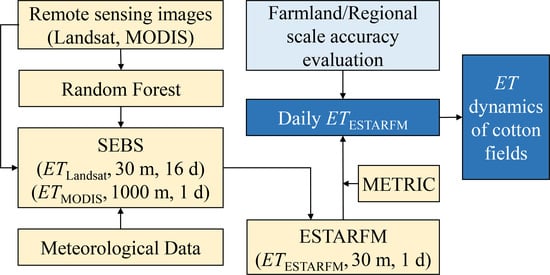Remote Sensing Data Fusion to Evaluate Patterns of Regional Evapotranspiration: A Case Study for Dynamics of Film-Mulched Drip-Irrigated Cotton in China’s Manas River Basin over 20 Years
Abstract
:1. Introduction
2. Materials and Methods
2.1. Overview of Study Area
2.2. SEBS for Estimating Daily ET
2.3. ESTARFM for Fusing Remote Sensing Data
2.4. Data Used for Remote Sensing Inversion and Model Validation
2.4.1. Remote Sensing Data
2.4.2. Meteorological Data
2.4.3. Ground Observation Data
- (1)
- Validation Data for ET
- (a)
- Irrigation experiment
- (b)
- Regional survey
- (c)
- Retrieved ET data
- (2)
- Data for Land-Use Classification and Accuracy Validation
2.5. Model Verification and Accuracy
2.5.1. Remote Sensing Identification of Cotton Fields
2.5.2. Verification of Estimated ET
3. Results and Discussion
3.1. Verification of ET Estimation
3.1.1. Fusion Accuracy of ESTARFM
3.1.2. Comparisons of ET Estimation with Measurements
- (1)
- Verifications at farmland scale
- (2)
- Verifications at regional scale
3.2. Dynamics of ET in CFFMDI in the MRB
3.2.1. Spatial Distribution Characteristics
3.2.2. Basin-Scale Intra-Season Dynamics of ET and Water Supply
3.2.3. Basin-Scale Inter-Season Dynamics of ET and its Sustainability Effects
- (1)
- Appropriately control the expansion of cultivated land and optimize cropping structure. If the total amount of available water resources cannot meet the requirements of cropland expansion and planned crop cropping systems, it may lead to the reduction in crop ET and yield [8] and may also increase the risk of secondary salinization because of the weakened leaching capacity of the root zone [37,40,41]. Based on the rigid constraint of irrigation water resource-bearing capacity, the potential scale of expansion of cultivated lands must be determined and crop planting optimized in order to maximize agricultural and water productivity and promote sustainable development [8,35].
- (2)
- Explore high-efficiency root-zone salt removal measures. The current mean value of root-zone soil salt content is about 4.8 g kg−1 in CFFMDI [29,32], representing a main factor inhibiting crop ET and yield in the arid MRB. Decreasing root-zone salt content will inevitably be beneficial for enhancing ET, yield, and water productivity [37,41,42]. Traditional salt removal measures of water conservancy projects, such as drainage ditches, subsurface pipes, and wells, utilize a large amount of water resources for leaching, which may often impede their wide application in an arid oasis such as the MRB. Therefore, it is necessary to further explore root-zone salt removal measures with low fresh-water consumption and high salt-drainage efficiency, e.g., biological reclamations [43], salt removal by fabric coverings [39], or even irrigation with water extremely low in salts made possible by desalination [40,42,44].
- (3)
- Strengthen the research on water-saving mechanisms and technologies to understand the ET dynamics of crops and reduce extravagant water consumption. Breeding and selection of drought- and salt-tolerant varieties, as well as the development and adoption of water-saving irrigation methods and agronomic measures (e.g., drip irrigation, mulching, no-tillage, regulated deficit irrigation scheduling, shading, etc.), can be useful to reduce water requirements or extravagant water consumption of crops without a cost to yield [45]. In addition, as shown in Figure 10, the water demand (TETp) of CFFMDI reached as high as about 700 mm during the growing season. This number was estimated using a method mainly for field crops without any consideration of the fact that the cotton was drip-irrigated under mulch. Further research is needed to investigate and quantify potential overestimation of TETp under conditions of film mulching [5].
4. Conclusions
- (1)
- The remote sensing inversion model of surface feature classification based on the RF algorithm reliably identified the CFFMDI in the MRB, with overall accuracy of identification above 0.88. Apparently, due to the continuous promotion and application of FMDI technology, a large number of originally salinized wastelands in the mid- and downstream areas of the MRB were gradually reclaimed into cotton fields, resulting in an area-wide annual expansion rate of 4.9% for the past 21 years.
- (2)
- By combining SEBS and ESTARFM, ET distributions were fused to meet the requirements of high spatial and temporal resolutions for CFFMDI in the MRB at both farmland and regional scales. The statistical characteristics of the fused results agreed well with those of measured series, with the coefficient of determination between them more than 0.77.
- (3)
- The spatial distribution of ET of cotton fields in the MRB, potentially affected by numerous complex factors such as topography, geomorphology, hydrology, farm management including irrigation, and salinization, indicated a number of phenomena. Fields with low ET values were mainly concentrated in the basin’s more seriously salinized areas, such as belts of shallow flowing groundwater, low-lying terrain, proximity to reservoirs and river channels, and the edge of desert, as well as other areas far away from rivers and thus difficult to irrigate. In general, the overall ET was found to gradually decrease from the upstream to the downstream zones, with the difference between them decreasing in recent years as ET decreased over the entire basin as a result of cotton field expansion and irrigation water supply shortage.
- (4)
- The intra-season daily distribution of ET varied over a large range but was characterized by a trend of first increasing to a single peak and then decreasing. This trend was contemporaneous with local hydrothermal changes mainly dominated by air temperature and irrigation. The minimum (0.61 mm d−1) and maximum (5.93 mm d−1) average ET of CFFMDI in the MRB appeared at the seedling stage and the flowering and boll setting stage, respectively. Over the 21 years from 2000 to 2020, the average total annual evapotranspiration TET was determined to be around 529.6 mm for the CFFMDI in the MRB. With the continuous increase in cotton field area and the gradual decrease in irrigation quotas, the TET decreased year by year, with an average decreasing rate of 7.5 mm year−1. By 2020, its value was as low as 415.7 mm, much lower than the local water requirement of cotton, 702.9 mm. In order to avoid non-sustainable utilization of water and soil resources, it is necessary to appropriately control the expansion scale of cultivated lands, optimize and adjust the cropping structure, explore efficient methods of root-zone salt removal, and strengthen research and development of water-saving agricultural mechanisms and technologies.
Supplementary Materials
Author Contributions
Funding
Data Availability Statement
Acknowledgments
Conflicts of Interest
References
- Xu, S.Q.; Yu, Z.B.; Yang, C.G.; Ji, X.B.; Zhang, K. Trends in evapotranspiration and their responses to climate change and vegetation greening over the upper reaches of the Yellow River Basin. Agric. For. Meteorol. 2018, 263, 118–129. [Google Scholar] [CrossRef]
- Allen, R.G.; Pereira, L.S.; Howell, T.A.; Jensen, M.E. Evapotranspiration information reporting: I. factors governing measurement accuracy. Agric. Water Manag. 2011, 98, 899–920. [Google Scholar] [CrossRef] [Green Version]
- Mu, Q.Z.; Zhao, M.S.; Running, S.W. Improvements to a MODIS global terrestrial evapotranspiration algorithm. Remote Sens. Environ. 2011, 115, 1781–1800. [Google Scholar] [CrossRef]
- Cammalleri, C.; Anderson, M.C.; Gao, F.; Hain, C.R.; Kustas, W.P. Mapping daily evapotranspiration at field scales over rainfed and irrigated agricultural areas using remote sensing data fusion. Agric. For. Meteorol. 2014, 186, 1–11. [Google Scholar] [CrossRef] [Green Version]
- Zhang, Z.Y.; Li, X.Y.; Liu, L.J.; Wang, Y.G.; Li, Y. Influence of mulched drip irrigation on landscape scale evapotranspiration from farmland in an arid area. Agric. Water Manag. 2019, 230, 105953. [Google Scholar] [CrossRef]
- Yang, Y.T.; Shang, S.H.; Jiang, L. Remote sensing temporal and spatial patterns of evapotranspiration and the responses to water management in a large irrigation district of North China. Agric. For. Meteorol. 2012, 164, 112–122. [Google Scholar] [CrossRef]
- Su, Z.B. The Surface Energy Balance System (SEBS) for estimation of turbulent heat fluxes. Hydrol. Earth Syst. Sci. 2002, 6, 85–99. [Google Scholar] [CrossRef]
- Bai, L.L.; Cai, J.B.; Liu, Y.; Chen, H.; Zhang, B.Z.; Huang, L.X. Responses of field evapotranspiration to the changes of cropping pattern and groundwater depth in large irrigation district of Yellow River basin. Agric. Water Manag. 2017, 188, 1–11. [Google Scholar] [CrossRef]
- Ning, S.R.; Zhou, B.B.; Shi, J.C.; Wang, Q.J. Soil water/salt balance and water productivity of typical irrigation schedules for cotton under film mulched drip irrigation in northern Xinjiang. Agric. Water Manag. 2021, 245, 106651. [Google Scholar] [CrossRef]
- Ning, S.R.; Shi, J.C.; Zuo, Q.; Wang, S.; Ben-Gal, A. Generalization of the root length density distribution of cotton under film mulched drip irrigation. Field Crop. Res. 2015, 177, 125–136. [Google Scholar] [CrossRef]
- Ma, J.L.; Liu, L.J.; Li, X.Y.; Wang, J.; Yang, H.J. Evapotranspiration process of cotton field under mulched drip irrigation of oasis in arid region. Chin. J. Ecol. 2015, 34, 974–981. [Google Scholar]
- Zhu, X.L.; Helmer, E.H.; Gao, F.; Liu, D.S.; Chen, J.; Lefsky, M.A. A flexible spatiotemporal method for fusing satellite images with different resolutions. Remote Sens. Environ. 2016, 172, 165–177. [Google Scholar] [CrossRef]
- Anderson, M.C.; Allen, R.G.; Morse, A.; Kustas, W.P. Use of Landsat thermal imagery in monitoring evapotranspiration and managing water resources. Remote Sens. Environ. 2012, 122, 50–65. [Google Scholar] [CrossRef]
- Zhao, R.; Du, S.H. Spectral-Spatial Residual Network for Fusing Hyperspectral and Panchromatic Remote Sensing Images. Remote Sens. 2022, 14, 800. [Google Scholar] [CrossRef]
- Busetto, L.; Meroni, M.; Colombo, R. Combining medium and coarse spatial resolution satellite data to improve the estimation of sub-pixel NDVI time series. Remote Sens. Environ. 2008, 112, 118–131. [Google Scholar] [CrossRef]
- Gao, F.; Masek, J.; Schwaller, M.; Hall, F. On the blending of the Landsat and MODIS surface reflectance: Predicting daily Landsat surface reflectance. IEEE Trans. Geosci. Remote Sens. 2006, 44, 2207–2218. [Google Scholar]
- Qiao, X.J.; Shi, J.C.; Tan, L.L.; Fan, W.H.; Xuan, J.W.; Sheng, J.D.; Zuo, Q. Multi-scale spatial distribution characteristics of soil salinity in root-zone in film-mulched drip-irrigated cotton fields in Anjihai irrigation zone, Xinjiang. Acta Pedol. Sin. 2021, 58, 1202–1213. [Google Scholar]
- Liang, S.L. Narrowband to broadband conversions of land surface albedo I: Algorithms. Remote Sens. Environ. 2001, 76, 213–238. [Google Scholar] [CrossRef]
- Sobrino, J.A.; Jiménez-Munoz, J.C.; Paolin, L. Land surface temperature retrieval from Landsat TM 5. Remote Sens. Environ. 2004, 90, 434–440. [Google Scholar] [CrossRef]
- Kustas, W.P.; Daughtry, C.S.T. Estimation of the soil heat flux/net radiation ratio from spectral data. Agric. For. Meteorol. 1990, 49, 205–223. [Google Scholar] [CrossRef]
- Su, Z.B.; Schmugge, T.; Kustas, W.P.; Massman, W.J. An evaluation of two models for estimation of the roughness height for heat transfer between the land surface and the atmosphere. J. Appl. Meteorol. 2001, 40, 1933–1951. [Google Scholar] [CrossRef] [Green Version]
- Brutsaert, W. Aspects of bulk atmospheric boundary layer similarity under free-convective conditions. Rev. Geophy. 1999, 37, 439–451. [Google Scholar] [CrossRef]
- Zhu, X.L.; Chen, J.; Gao, F.; Chen, X.H.; Masek, J.G. An enhanced spatial and temporal adaptive reflectance fusion model for complex heterogeneous regions. Remote Sens. Environ. 2010, 114, 2610–2623. [Google Scholar] [CrossRef]
- Allen, R.G.; Tasumi, M.; Trezza, R. Satellite-based energy balance for mapping evapotranspiration with internalized calibration(METRIC)-model. J. Irrig. Drain. Eng. 2007, 133, 380–394. [Google Scholar] [CrossRef]
- Wang, Z.; Zhang, F.; Zhang, X.; Chan, N.W.; Kung, H.; Zhou, X.; Wang, Y. Quantitative evaluation of spatial and temporal variation of soil salinization risk using GIS-based geostatistical method. Remote Sens. 2020, 12, 2405. [Google Scholar] [CrossRef]
- Wang, W.J.; Zhang, X.; Zhao, Y.D.; Wang, S.D. Cotton extraction method of integrated multi-features based on multitemporal Landsat 8 images. J. Remote Sens. 2017, 21, 115–124. [Google Scholar] [CrossRef]
- Hou, D.Y.; O’Connor, D.; Nathanail, P.; Tian, L.; Ma, Y. Integrated GIS and multivariate statistical analysis for regional scale assessment of heavy metal soil contamination: A critical review. Environ. Pollut. 2017, 231, 1188–1200. [Google Scholar] [CrossRef]
- Tan, S.; Wang, Q.; Zhang, J.; Chen, Y.; Shan, Y.; Xu, D. Performance of AquaCrop model for cotton growth simulation under film-mulched drip irrigation in southern Xinjiang, China. Agric. Water Manag. 2018, 196, 99–113. [Google Scholar] [CrossRef]
- Liu, L.N.; Wang, T.S.; Wang, L.C.; Wu, X.; Zuo, Q.; Shi, J.C.; Sheng, J.D.; Jiang, P.A.; Chen, Q.J.; Ben-Gal, A. Plant water deficit index-based irrigation under conditions of salinity. Agric. Water Manag. 2022, 269, 107669. [Google Scholar] [CrossRef]
- Van Niel, T.G.; McVicar, T.R.; Datt, B. On the relationship between training sample size and data dimensionality: Monte Carlo analysis of broadband multi-temporal classification. Remote Sens. Environ. 2005, 98, 468–480. [Google Scholar] [CrossRef]
- Cohen, J. A coefficient of agreement for nominal scales. Educ. Psychol. Meas. 1960, 20, 37–46. [Google Scholar] [CrossRef]
- Meng, C.R.; Yan, L.; Zhang, S.J.; Wei, C.Z. Variation of soil salinity in plow layer of farmlands under long-term mulched drip irrigation in arid region. Acta Pedol. Sin. 2017, 54, 1386–1394. [Google Scholar]
- Cheng, W.M.; Zhou, C.H.; Liu, H.J.; Zhang, Y.; Jiang, Y.; Zhang, Y.C.; Yao, Y.H. Oasis 50-year expansion and evolution of the ecological environment in Manas River Basin. Sci. China Ser. D Earth Sci. 2006, 49, 163–175. [Google Scholar] [CrossRef]
- Zhou, S.Q.; Wang, J.; Liu, J.X.; Yang, J.H.; Xu, Y.; Li, J.H. Evapotranspiration of a drip-irrigated, film-mulched cotton field in northern Xinjiang, China. Hydrol. Process. 2012, 26, 1169–1178. [Google Scholar] [CrossRef]
- Bai, J.; Wang, J.; Chen, X.; Luo, G.; Shi, H.; Li, L.; Li, J. Seasonal and inter-annual variations in carbon fluxes and evapotranspiration over cotton field under drip irrigation with plastic mulch in an arid region of Northwest China. J. Arid Land 2015, 7, 272–284. [Google Scholar] [CrossRef] [Green Version]
- Teuling, A.J.; Hirschi, M.; Ohmura, A.; Wild, M.; Reichstein, M.; Ciais, P.; Buchmann, N.; Ammann, C.; Montagnani, L.; Richardson, A.D.; et al. A regional perspective on trends in continental evaporation. Geophys. Res. Lett. 2009, 36, L02404. [Google Scholar] [CrossRef] [Green Version]
- Minhas, P.S.; Ramos, T.; Ben-Gal, A.; Pereira, L.S. Coping with salinity in irrigated agriculture: Crop evapotranspiration and water management issues. Agric. Water Manag. 2020, 227, 105832. [Google Scholar] [CrossRef]
- Statistics Bureau of Xinjiang Uygur Autonomous Region. Xinjiang Statistical Yearbook; China Statistics Press: Beijing, China, 2001–2020; Available online: https://navi.cnki.net/knavi/yearbooks/YXJTJ/detail?uniplatform=NZKPT (accessed on 16 September 2021).
- Xu, Z.Q.; Mao, X.M.; Adeloye, A.J.; Hu, K.J.; Zhu, Y.; Ma, X.W. Geotextile covering: Potential technique for farmland salinization control. Land Degrad. Dev. 2021, 32, 2493–2508. [Google Scholar] [CrossRef]
- Raveh, E.; Ben-Gal, A. Irrigation with water containing salts: Evidence from a macro-data national case study in Israel. Agric. Water Manag. 2016, 170, 176–179. [Google Scholar] [CrossRef]
- Hopmans, J.W.; Qureshi, A.S.; Kisekka, I.; Munns, R.; Grattan, S.R.; Rengasamy, P.; Ben-Gal, A.; Assouline, S.; Javaux, M.; Minhas, P.S.; et al. Critical Knowledge Gaps and Research Priorities in Global Soil Salinity. Adv. Agron. 2021, 169, 1–191. [Google Scholar] [CrossRef]
- Raveh, E.; Ben-Gal, A. Leveraging sustainable irrigated agriculture via desalination: Evidence from a macro-data case study in Israel. Sustainability 2018, 10, 974. [Google Scholar] [CrossRef] [Green Version]
- Bao, A.K.; Guo, Z.G.; Zhang, H.F.; Wang, S.M. A procedure for assessing the salt tolerance of lucerne (Medicago sativa L.) cultivar seedlings by combining agronomic and physiological indicators. N. Z. J. Agric. Res. 2009, 52, 435–442. [Google Scholar] [CrossRef]
- Kaner, A.; Tripler, E.; Hadas, E.; Ben-Gal, A. Feasibility of desalination as an alternative to irrigation with water high in salts. Desalination 2017, 416, 122–128. [Google Scholar] [CrossRef]
- Han, L.J.; Ding, J.L.; Wang, J.J.; Zhang, J.Y.; Xie, B.Q.; Hao, J.P. Monitoring Oasis Cotton Fields Expansion in Arid Zones Using the Google Earth Engine: A Case Study in the Ogan-Kucha River Oasis, Xinjiang, China. Remote Sens. 2022, 14, 225. [Google Scholar] [CrossRef]
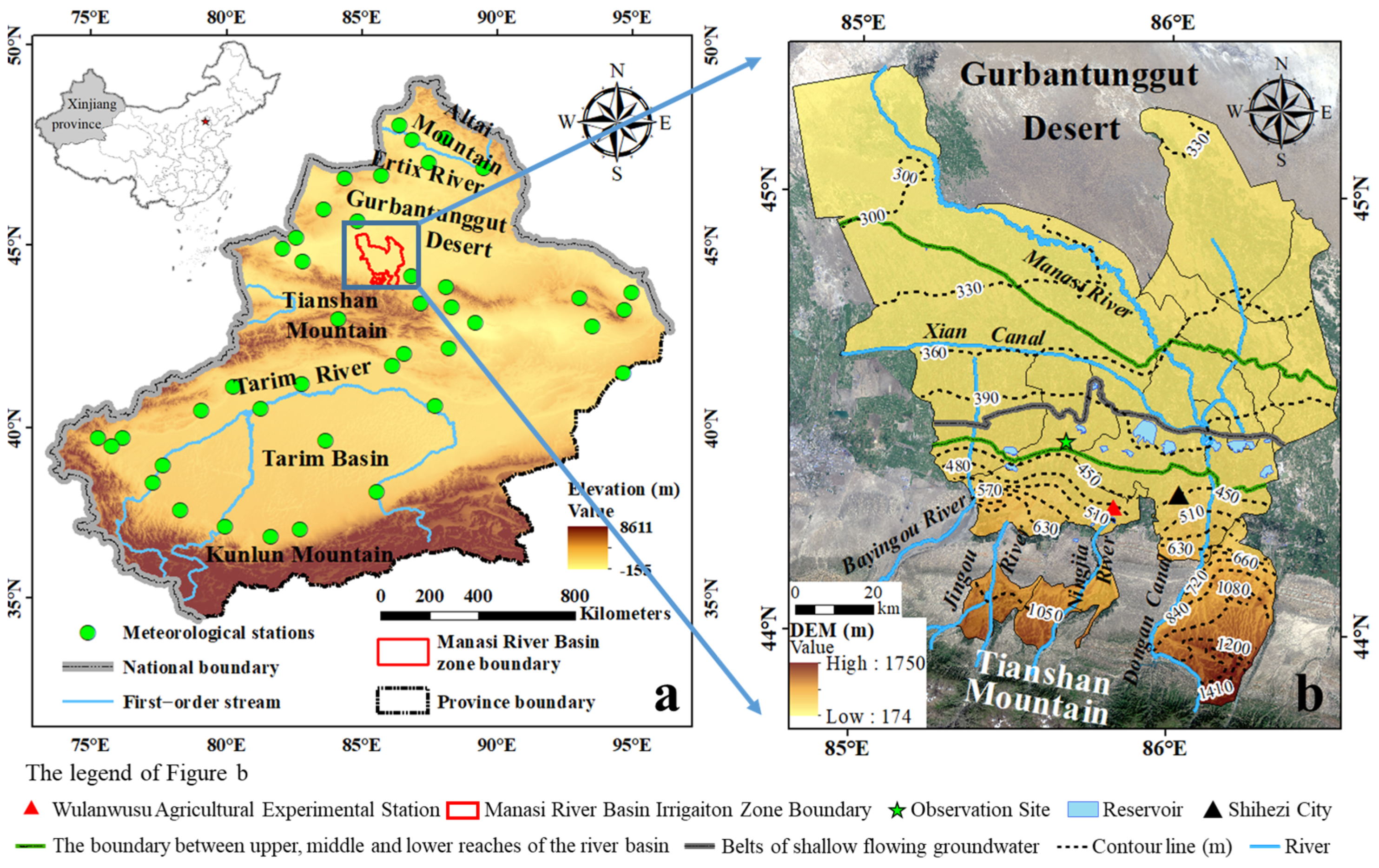
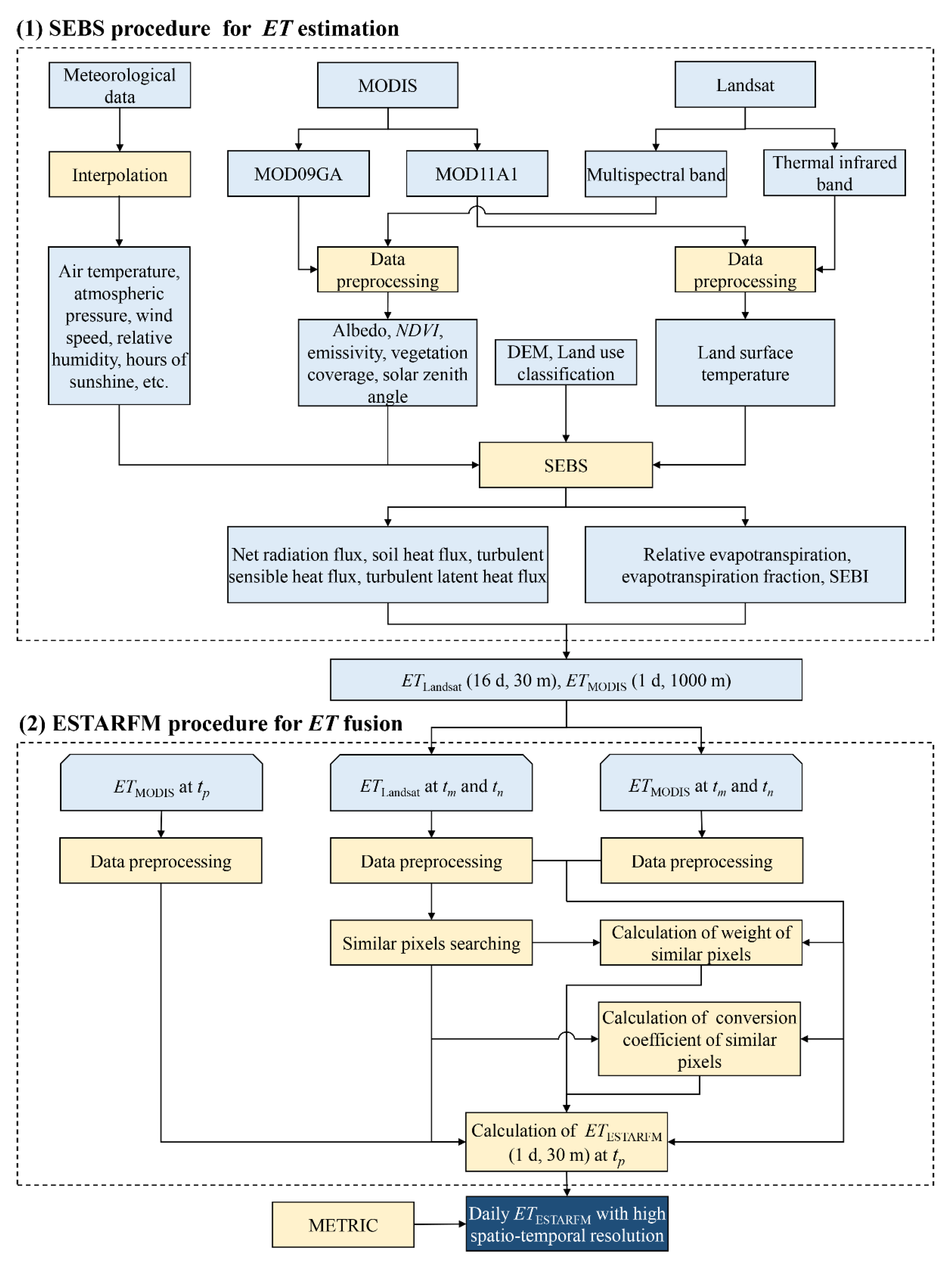

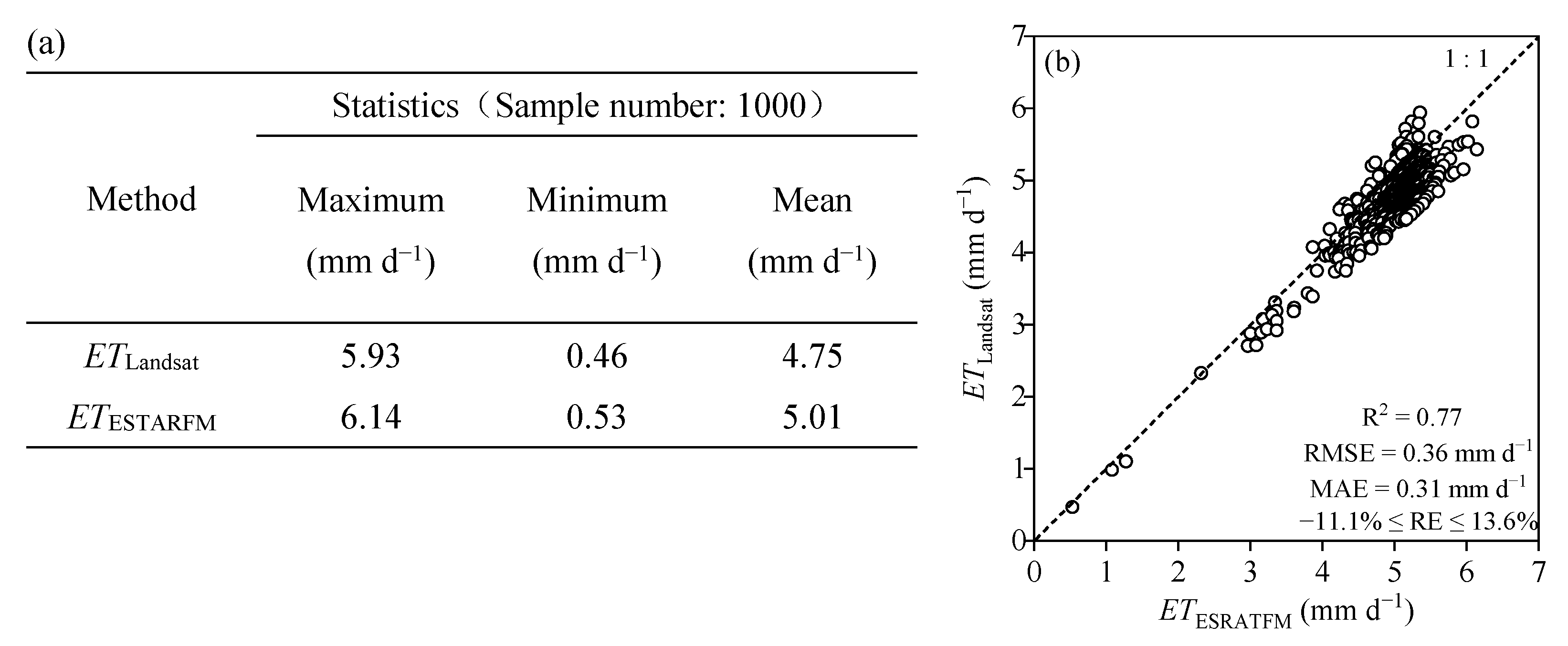
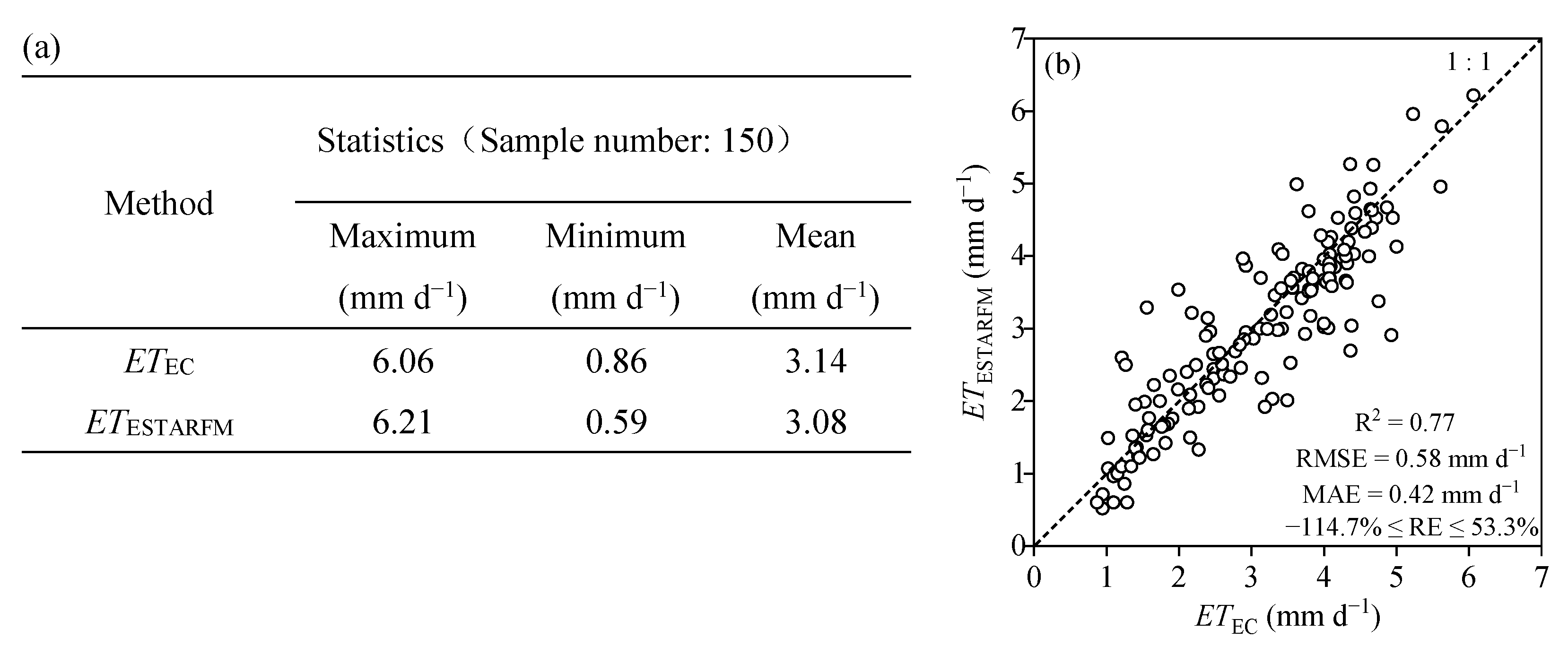
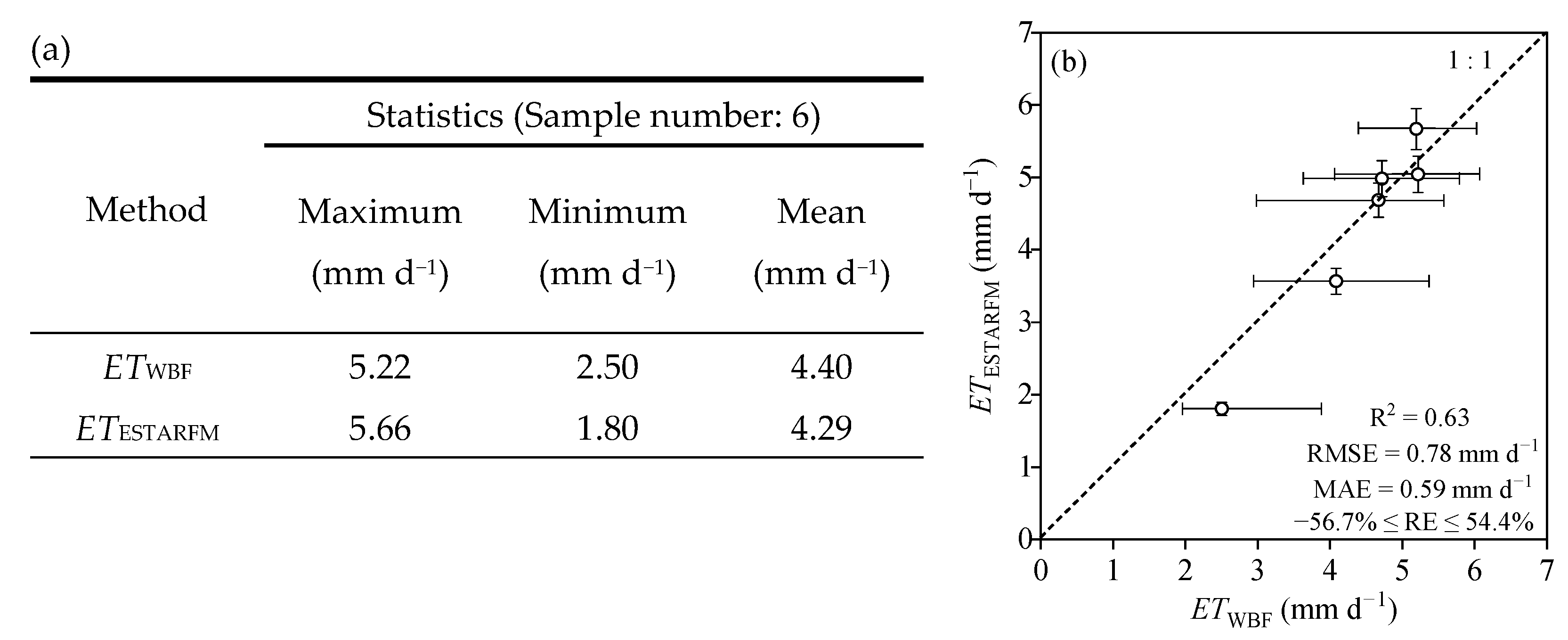
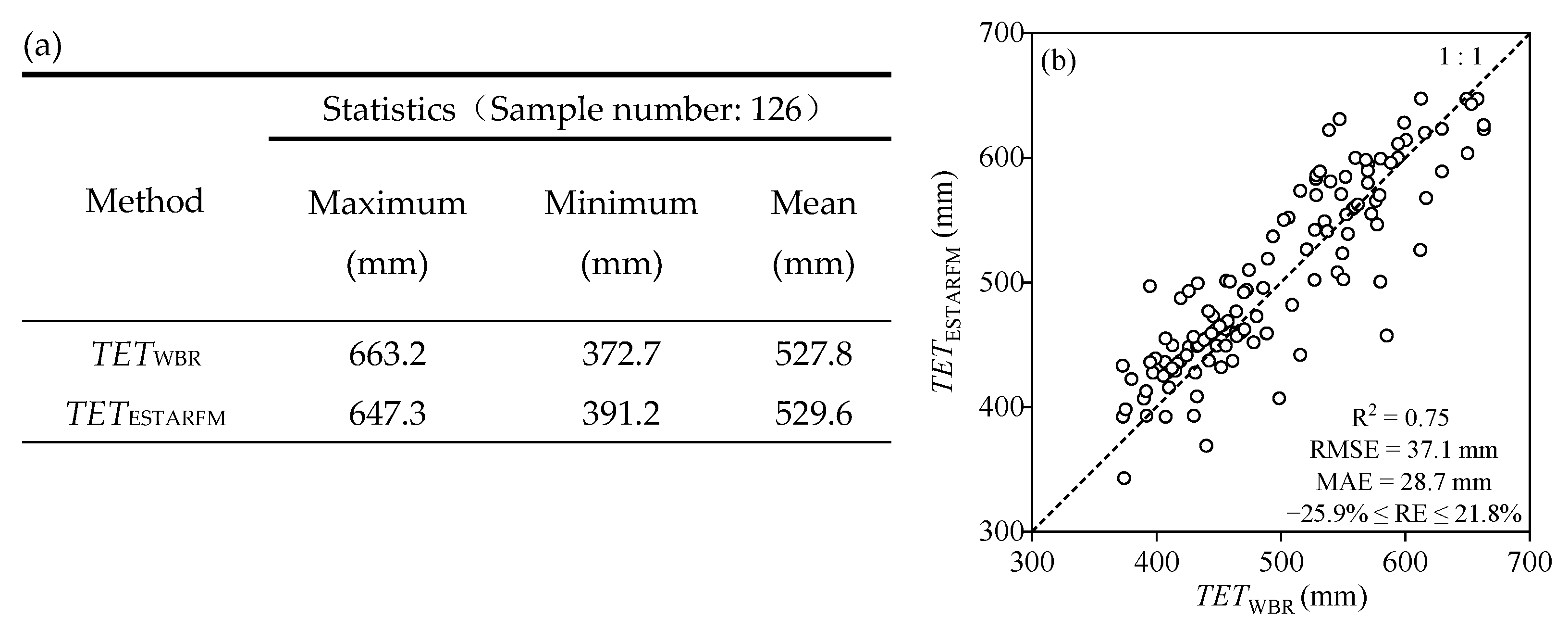
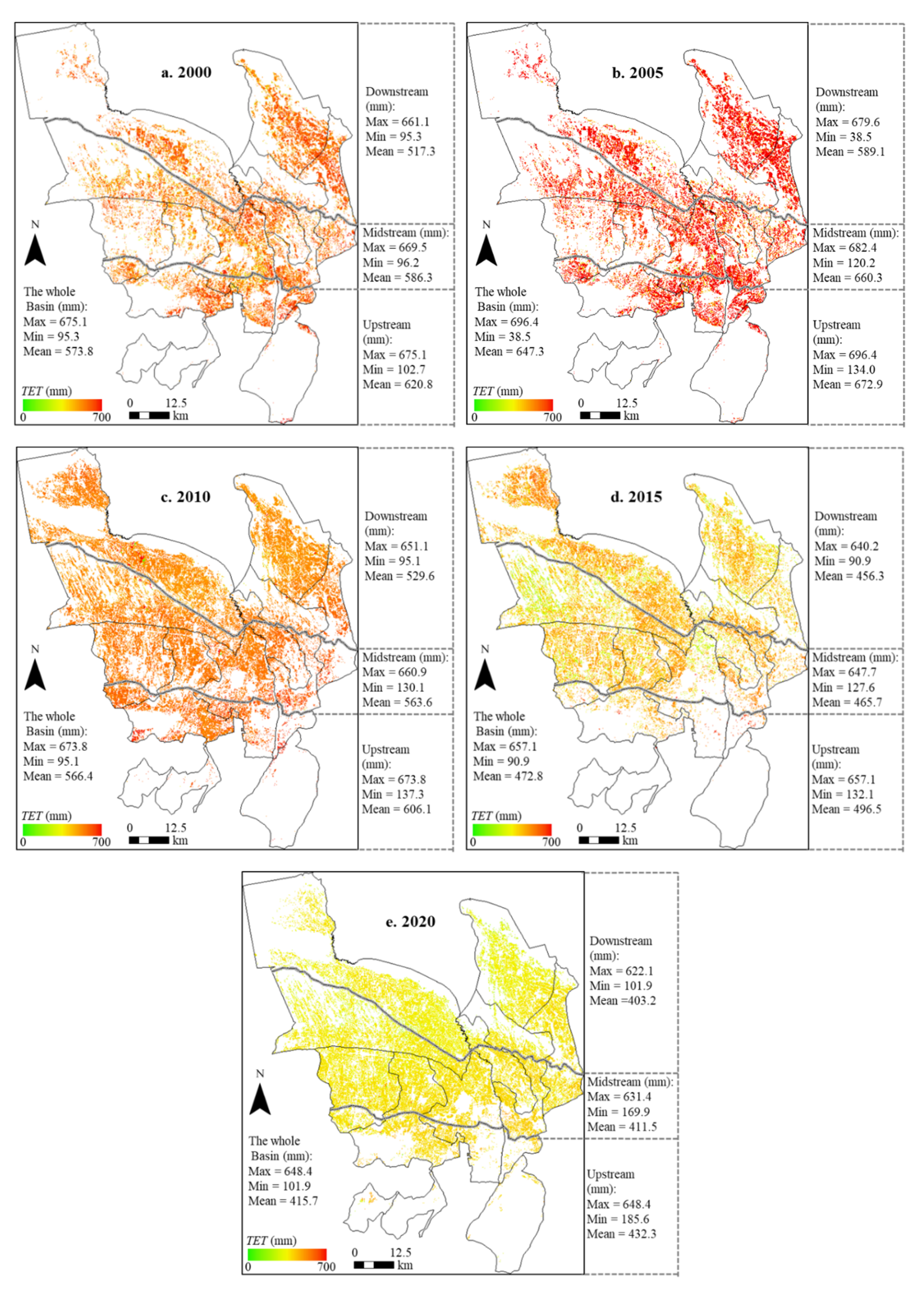
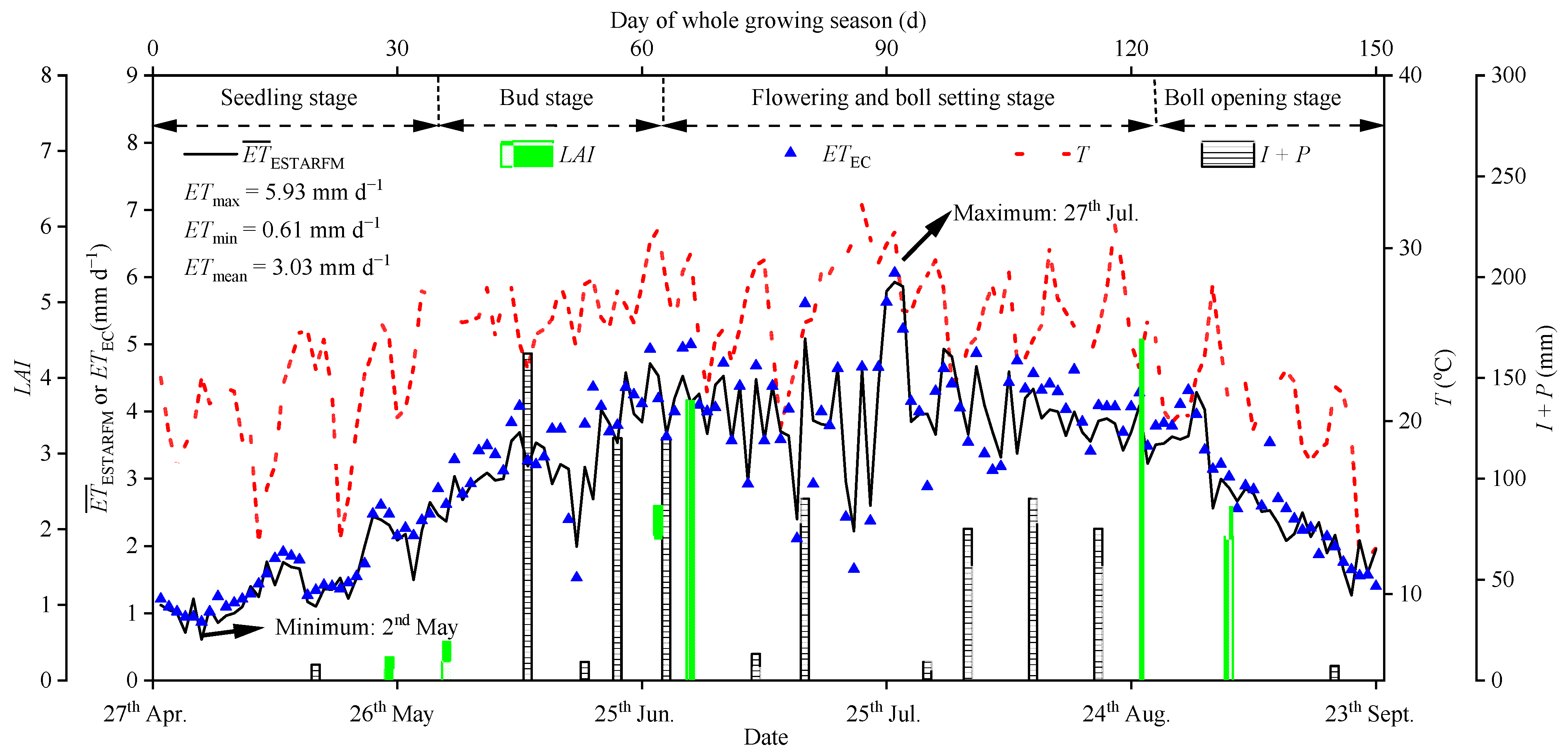

Publisher’s Note: MDPI stays neutral with regard to jurisdictional claims in published maps and institutional affiliations. |
© 2022 by the authors. Licensee MDPI, Basel, Switzerland. This article is an open access article distributed under the terms and conditions of the Creative Commons Attribution (CC BY) license (https://creativecommons.org/licenses/by/4.0/).
Share and Cite
Qiao, X.; Yang, G.; Shi, J.; Zuo, Q.; Liu, L.; Niu, M.; Wu, X.; Ben-Gal, A. Remote Sensing Data Fusion to Evaluate Patterns of Regional Evapotranspiration: A Case Study for Dynamics of Film-Mulched Drip-Irrigated Cotton in China’s Manas River Basin over 20 Years. Remote Sens. 2022, 14, 3438. https://doi.org/10.3390/rs14143438
Qiao X, Yang G, Shi J, Zuo Q, Liu L, Niu M, Wu X, Ben-Gal A. Remote Sensing Data Fusion to Evaluate Patterns of Regional Evapotranspiration: A Case Study for Dynamics of Film-Mulched Drip-Irrigated Cotton in China’s Manas River Basin over 20 Years. Remote Sensing. 2022; 14(14):3438. https://doi.org/10.3390/rs14143438
Chicago/Turabian StyleQiao, Xuejin, Guang Yang, Jianchu Shi, Qiang Zuo, Lining Liu, Mu Niu, Xun Wu, and Alon Ben-Gal. 2022. "Remote Sensing Data Fusion to Evaluate Patterns of Regional Evapotranspiration: A Case Study for Dynamics of Film-Mulched Drip-Irrigated Cotton in China’s Manas River Basin over 20 Years" Remote Sensing 14, no. 14: 3438. https://doi.org/10.3390/rs14143438





